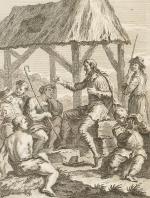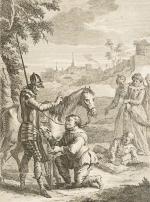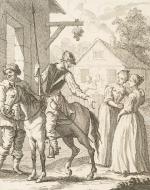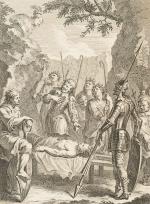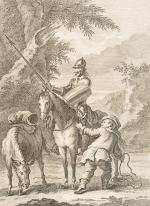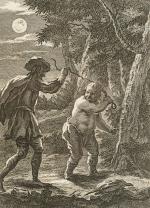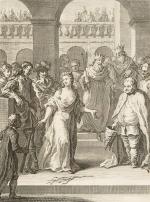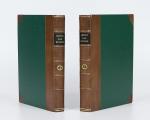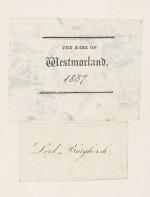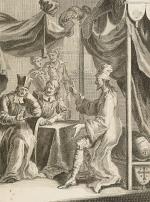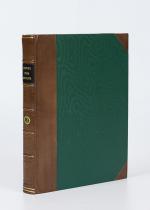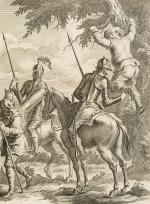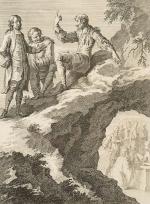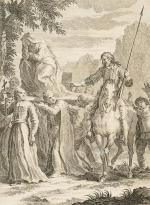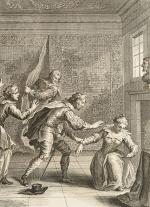Cervantes De Saavedra, The Life and Exploits of the Ingenious Gentleman Don Quix
The Life and Exploits of the Ingenious Gentleman Don Quixote de la Mancha. Translated from the Original Spanish by Charles Jarvis, Esq. [Bound with: “The Life of Michael de Cervantes Saavedra” and an “Advertisement concerning the Plates”].
Second issue of the First Jarvis Edition. Two Volumes (complete set). London, J. & R. Tonson and R. Dodsley, 1738-1742. Quarto. Pagination: Volume I: Frontispiece, XXIV, (8), I – [XXIV], (interrupted with 8 unnumbered pages: “Supplement to the Translator’s Preface,” on the origin of books of chivalry, [by Wiliam Warburton]), continued pagination [XXV-XXXII], Second Frontispiece (Portrait of Cervantes by George Vertue after G. Kent), V, (2), 355 pages with 28 copperplates (including the two frontispieces). Volume II: XII, 388 pages with 41 copperplate illustrations. In total 69 copperplate engravings, all drawn by John Vanderbank and engraved by Gerard van der Gucht / Vandergucht. Modern Hardcover bindings by an english masterbinder, styled to the 18th century period and with new endpapers that carry the original bookplates / Exlibris of John Fane, (Lord Burgersh) the Earl of Westmoreland. Excellent condition with only minor signs of foxing to the outer margins of the pages. All illustrations in strong and fresh imprint. An excellent set from a famous library.
This exceptional Don Quixote – publication is more than just an early edition but ratherone of the most desired translations of this masterpiece. The Translator’s Preface is a short history and early literary criticism of Cervantes’ Don Quixtoe – Edition of the early 18th century. Charles Jervas (here incorrectly “Jarvis”, is openly attacking previous Quixote-Editions by Stevens, Shelton, Motteux (″The edition by John Stevens is but a bare attempt to correct some passages of Shelton, and, though the grammar be a little mended by the connecting particles, the antique stile [sic] of the old one is entirely broken”).
History of the Translator Charles Jervas [incorrect “Jarvis”]:
Charles Jervas (also Jarvis; c. 1675 – 2 November 1739) was an Irish portrait painter, translator, and art collector of the early 18th century. Born in Clonlisk, County Offaly, Ireland around 1675, the son of John Jervas and Elizabeth, daughter of Captain John Baldwin of Shinrone Castle & Corolanty, High Sheriff of County Offaly. Jervas studied in London, England as an assistant under Sir Godfrey Kneller between 1694 and 1695.
Painting portraits of the city’s intellectuals, among them such personal friends as Jonathan Swift and the poet Alexander Pope (both now in the National Portrait Gallery, London), Charles Jervas became a popular artist often referred to in the works of literary figures of the period.
Jervas gave painting lessons to Pope at his house in Cleveland Court, St James’s, which Pope mentions in his poem, To Belinda on the Rape of the Lock, written 1713, published 1717 in ‘Poems on Several Occasions’.
Pope’s verse Epistle to Mr Jervas, written circa 1715, was published in the 1716 edition of John Dryden’s 1695 translation of Fresnoy’s Art of Painting (Charles Alphonse Du Fresnoy’s De arte graphica, 1668).
With his growing reputation, Jervas succeeded Kneller as Principal Painter in Ordinary to King George I in 1723, and continued to live in London until his death in 1739.
His translation of Cervantes’ novel Don Quixote, published posthumously in 1742 as being made by Charles “Jarvis” – because of a printer’s error – has since come to be known as “the Jarvis translation”. Jervas was first to provide an introduction to the novel including a critical analysis of previous translations of Don Quixote. It has been highly praised as the most accurate translation of the novel up to that time, but also strongly criticised for being stiff and humourless, although it went through many printings during the 19th century. (Wikipedia)
″His [Charles Jarvis] major literary undertaking was an English translation of Cervantes’ Don Quixote. Published posthumously in 1742 and frequently reprinted, it is generally acknowledged as being close in spirit to the original.” [Source: ODNB – Oxford Dictionary of National Biography].
Regarding the Provenance:
John Fane, 11th Earl of Westmorland GCB GCH PC (2 February 1784 – 16 October 1859), styled Lord Burghersh until 1841, was a British soldier, politician, diplomat and musician. Styled Lord Burghersh from birth, he was born at Sackville Street, Piccadilly, London, the son of John Fane, 10th Earl of Westmorland, by his wife Sarah Child, daughter and heiress of the wealthy banker Sir Robert Child, builder of Osterley Park. His sister was the well known social hostess Sarah Villiers, Countess of Jersey, and his uncle was William Lowther, 1st Earl of Lonsdale, a Tory magnate from northern England. He was educated at Cheam School and then at Harrow from 1797 to 1799. Burghersh was admitted to Trinity College, Cambridge on 28 January 1802 and received an M.A. in 1808. He succeeded his father in the earldom in 1841.
On 9 May 1803, Burghersh was appointed a deputy lieutenant of Northamptonshire, and after the breakdown of the Peace of Amiens, he was commissioned a lieutenant in the Northamptonshire Militia on 30 June 1803. He entered the regular army as an ensign in the 11th Foot, without purchase, on 24 December 1803. On 5 January 1804 he transferred to the 7th Foot as a lieutenant and on 3 May 1805 he transferred to the 23rd Foot as a captain. He exchanged on 1 November to the 3rd Dragoon Guards, and served as aide-de-camp to Sir George Don when the latter led reinforcements to Hanover.
As early as 1802, his uncle Lord Lonsdale had contemplated putting Burghersh into Parliament for Londsdale’s pocket borough of Cockermouth when Burghersh came of age; in fact, his uncle Thomas stepped down and Burghersh was returned for the Fane constituency of Lyme Regis at the ensuing by-election on 16 March 1806. Three days later he joined Brooks’s Club, traditionally a resort of Whigs and particularly Foxite, but on 30 April 1806 voted with the Pitt administration (in which his father was Lord Privy Seal) against the repeal of the Additional Forces Act. Shortly thereafter, he was sent abroad, serving as assistant adjutant general to the forces in Sicily and Egypt from 1806 to 1807. He was with Admiral Duckworth’s fleet during the Dardanelles Operation and then took part in the Alexandria expedition of 1807.
Burghersh was a supporter of the second Portland Ministry, in which his father was again Lord Privy Seal, but without particular activity in Parliament, appearing once in debate on the price of wheat on 3 June 1808. He joined the army in Portugal led by Sir Arthur Wellesley in that year, and fought at Roliça and Vimiero in August.
On 6 May 1809, he was gazetted major in the 2nd West India Regiment in place of Thomas McMahon, sent to Lord Beresford’s staff in Portugal, and lieutenant colonel on 9 May when he was himself sent to Portugal, This exceedingly rapid promotion, over the heads of many senior officers, drew the attention of William Shipley, member for Flint and recently retired as a lieutenant colonel. He moved that Burghersh’s promotion was in violation of Army regulations, and the resolution was carried by the House of Commons. Lord Westmorland was compelled to ask the King not to sign Burghersh’s commissions, and they were accordingly cancelled. In July, Burghersh was actively engaged at the Battle of Talavera. He soon after replied to a letter of his father’s on his abortive promotion in May, telling him that “the military is a profession which I most sincerely love,” but expressing his frustration at not occupying a situation more equal to his education and qualities. He served with the 3rd Dragoon Guards in their campaign in Portugal in 1810.
On 16 February 1811, he purchased a majority in the 83rd Foot, then transferred to the half-pay of the 91st Foot on 21 March. On 10 December 1811 he exchanged back into the 7th Foot and later the same year purchased a lieutenant-colonelcy in the 63rd Foot. On 4 June 1814, he was appointed an extra aide-de-camp to the Prince Regent and promoted to colonel in the Army. He was an extra aide-de-camp to the Duke of Wellington (his wife’s uncle) and fought at Talavera and Busaco during the Peninsular War. On 4 June 1815, Burghersh was appointed a CB. He was promoted major general on 27 May 1825. Made a KCB on 25 February 1838, he was promoted lieutenant general on 28 June 1838 and general in 1854 and was appointed Colonel of the 56th Foot in 1842.
Lord Westmorland sat as a Member of Parliament (MP) for Lyme Regis between 1806 and 1816. He served as Minister to Tuscany between 1814 and 1830, as Envoy Extraordinary and Minister Plenipotentiary to Prussia between 1841 and 1851 and as Ambassador to the Austrian Empire between 1851 and 1855. In Vienna, he was one of the British representatives at the congress of 1855.
During the Revolutions of 1820 he was accused by the Austrian Government of actively supporting the Revolution in Naples, and was urged by his own Government to show more discretion. Westmorland defended his conduct by arguing that while he was “no Jacobin” and had no sympathy with the revolutionaries, he was concerned that the Austrians would put down the revolution with such brutality that further political disturbance was inevitable.
He was appointed a Companion of the Order of the Bath in 1815, a Knight Grand Cross of the Royal Guelphic Order (KCH) in 1817, a Knight Commander of the Order of the Bath (KCB) in 1838 and a Knight Grand Cross of the Order of the Bath (GCB) in 1846 and was sworn of the Privy Council in 1822.
Lord Westmorland was also a composer and a founder of the Royal Academy of Music. He was a great music lover who devoted most of his leisure hours to the study of music, was a good violinist and a prolific composer.
Lord Westmorland married Priscilla Anne Pole-Wellesley, daughter of the Honourable William Wellesley-Pole, later first Baron Maryborough and third Earl of Mornington and Katherine Elizabeth Forbes, on 26 June 1811. They had six children:
Lady Rose Sophia Mary Fane (died 4 February 1921), married Henry Weigall and had issue, including Gerry Weigall and Archibald Weigall
Hon. John Arthur Fane (12 February 1816 – 29 August 1816)
George Augustus Frederick John Fane, Lord Burghersh (18 June 1819 – 29 April 1848)
Ernest Fitzroy Neville Fane, Lord Burghersh (7 January 1824 – 22 June 1851)
Francis Fane, 12th Earl of Westmorland (1825–1891)
Hon. Julian Henry Charles Fane (10 October 1827 – 19 April 1870)
He died in October 1859, aged 75, and was succeeded in the earldom by his fourth but eldest surviving son, Francis. Lord Westmorland’s fifth and youngest son Julian Fane was a poet and diplomat. The Countess of Westmorland died in February 1879. (Source: Wikipedia)
History of the illustrators John Vanderbank & Gerard van der Gucht:
John Vanderbank (9 September 1694 – 23 December 1739) was an English portraitist and book illustrator, who enjoyed a high reputation for a short while during the reign of King George I, but who died relatively young due to an intemperate and extravagant lifestyle. Vanderbank’s portraits, among which are those of many eminent persons, are skilfully drawn and full of character, but slight and careless in execution. He had a great talent for historical composition, and Vertue spoke highly of some of his works of this class.
Vanderbank’s book illustrations include: the portrait of Sir Isaac Newton used in the frontispiece of the 1726 edition of Principia; the 66 plates of the first edition in Spanish of Cervantes’ Don Quixote published in London (1738); and illustrations for ‘Twenty-five Actions of the Manage Horse, engraved by Josephus Sympson (1729). His 1725 portrait of Sir Isaac Newton hangs in Trinity College, Cambridge. Many of his portraits were engraved by John Faber Jr. and George White. Vanderbank was amongst a group of artists painted by William Hogarth, of which there is an engraving by R. Sawyer. (Wikipedia)
Gerard Vandergucht (or van der Gucht) (1696/97 – 18 March 1776) was an English engraver and art dealer.
Vandergucht, born in London, the elder son of the Flemish engraver Michael Vandergucht. He was taught engraving by his father, as was his younger brother Jan Vandergucht (or John) (c.1699-c.1730). Gerard was also taught drawing by Louis Chéron, and studied at Godfrey Kneller’s Great Queen Street Academy. He surpassed the restrained style of engraving favoured by his father, and became one of the leading engravers in London by adopting the French method of combining precise engraving with etched tones.
In 1719, he was commissioned by James Thornhill to engrave four designs for the cupola of St Paul’s Cathedral. He took over his father’s house – the Golden Head in Queen Street, Bloomsbury – following his father’s death in 1725. He married Mary Liney on 24 August, 1725. They had over 30 children, including the painter and picture dealer Benjamin Vandergucht.
He became a leading publisher of engraved prints and book illustrations, and taught Robert White and Francis Patton.
In 1735, he took a leading role in the artists’ demands for copyright protection which led to an extension of the provisions established by William Hogarth in the Engraving Copyright Act. The 1735 act only protected original designs. Vandergucht and his supporters successfully lobbied to extend copyright protection to cover all prints.
He concentrated on art dealing in the last 16 years of his life, selling prints, drawings, paintings and statues. He was a member of the Society for the Encouragement of Arts, Manufactures, and Commerce. He moved to Vandyke’s Head, Great Brook Street, in 1758, where he died in 1776. (Wikipedia)
- Keywords: 18th Century – Rare · Books on Books · Books on Books Rare · Catalogue Four – International Art · Catalogue No.10 – International Literature · Catalogue Ten – International Literature · Catalogue Winter 2020 / 2021 · Cervantes · Don Quixote First Edition · Gift Ideas Rare · Illustrated Books Rare · International Literature – Rare · Provenance · Spanish History – Rare · Spanish Literature – Rare · Very Special Books Rare · WCBF Highlight · West Cork Rare Book Fair 2022
- Language: English
- Inventory Number: 28892AB
EUR 4.800,--
© 2025 Inanna Rare Books Ltd. | Powered by HESCOM-Software





